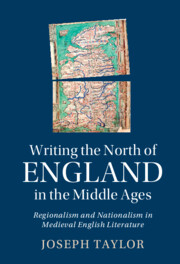 Writing the North of England in the Middle Ages
Writing the North of England in the Middle Ages Book contents
- Writing the North of England in the Middle Ages
- cambridge studies in medieval literature
- Writing the North of England in the Middle Ages
- Copyright page
- Dedication
- Contents
- Acknowledgments
- Chapter 1 Introduction: Region and Nation in England’s North–South Divide
- Chapter 2 William of Malmesbury, Bede, and the Problem of the North
- Chapter 3 The North–South Divide in the Medieval English Universities
- Chapter 4 Chaucer’s Northern Consciousness in the Reeve’s Tale
- Chapter 5 Centralization, Resistance, and the North of England in A Gest of Robyn Hode
- Chapter 6 The Towneley Plays, the Pilgrimage of Grace, and Northern Messianism
- Chapter 7 Conclusion: A Medieval and Modern North–South Divide
- Notes
- Works Cited
- Index
- Cambridge Studies in Medieval Literature
Chapter 2 - William of Malmesbury, Bede, and the Problem of the North
Published online by Cambridge University Press: 08 December 2022
- Writing the North of England in the Middle Ages
- cambridge studies in medieval literature
- Writing the North of England in the Middle Ages
- Copyright page
- Dedication
- Contents
- Acknowledgments
- Chapter 1 Introduction: Region and Nation in England’s North–South Divide
- Chapter 2 William of Malmesbury, Bede, and the Problem of the North
- Chapter 3 The North–South Divide in the Medieval English Universities
- Chapter 4 Chaucer’s Northern Consciousness in the Reeve’s Tale
- Chapter 5 Centralization, Resistance, and the North of England in A Gest of Robyn Hode
- Chapter 6 The Towneley Plays, the Pilgrimage of Grace, and Northern Messianism
- Chapter 7 Conclusion: A Medieval and Modern North–South Divide
- Notes
- Works Cited
- Index
- Cambridge Studies in Medieval Literature
Summary
Chapter 2 explores the reshaping of English history by Latin historiographers writing in the wake of the Norman Conquest. These historians sought to incorporate the Conquest’s political rupture into seamless histories that intimated a longstanding English nation. At the forefront of this movement was William of Malmesbury. In his writing, William, however, must confront the regionalism or “northern-ness” of his chief source and inspiration, Bede, the venerable “Father of English History.” This chapter analyses how William labors to deaden Bede’s northern-ness and, further, how William engages the ruinous North of England, still smouldering from King William I’s “Harrying of the North” in 1069–70. In this destruction of the North, born of its rebelliousness, William of Malmesbury finds a startling microcosm for England. William recalls the North’s glorious Roman past, evident in the wrecked buildings of Roman vintage, that darkly forecast for the Wiltshire monk the potential failures of the larger English nation, such that it will become a ruin itself much like the city of Rome in Hildebert of Lavardin’s poem “par tibi Roma nihil,” which William quotes extensively in his work.
- Type
- Chapter
- Information
- Writing the North of England in the Middle AgesRegionalism and Nationalism in Medieval English Literature, pp. 32 - 62Publisher: Cambridge University PressPrint publication year: 2022


